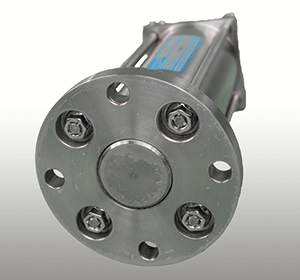
Neu Matics specialises in the design and installation of pneumatic control systems and the manufacture of cylinders and control panels. The company offers services ranging from pneumatic logic system and PLC design, to technical advice on all aspects of pneumatics, including bus electronics. It also acts as sole distributor for a range of internationally recognised brands, and one of these is the pneumatic knocker from singold, a specialist in material flow solutions with over 50 years experience in bulk material technology.

Pneumatic knockers are a type of cylinder that delivers a knock or impact at variable intervals in order to make bulk materials flow better. They are used on containers and silos with material flow problems such as residue buildup, where high-speed vibrators or shakers with soft sinusoidal oscillations are not effective. They reliably remove product residues, caking, and shaft and bridge buildups in a wide variety of manufacturing applications. They are effective, reliable and inexpensive.
What are the advantages of pneumatic knockers?
Have you ever walked through your plant and seen impact marks on cyclones, bins or silos? In all those cases where the flow of material was restarted with a hammer blow, a pneumatic knocker could have been used more efficiently and with less impact on the material. Unlike shakers, vibrators, and even interval knockers, a pneumatic magnetic system knocker can knock on demand, whenever it is needed.
This provides the following advantages:
• For some products, constant knocking tends to condense the material flow rather than promote it. A single, targeted blow is much more effective here than a vibrator.
• Well-directed knocking contributes to noise protection in the factory.
• The impact from the singold knocker only generates a vibration with a large amplitude and does not go through any self-resonance. In contrast to vibrators, this protects the container and the knocker in the best possible way.
• Compressed air consumption is reduced.
• There is no imbalance as with vibrators.
The knocker generates a shock that causes the container wall to vibrate in a decaying manner. The number of vibrations is lower than when using shakers and vibrators, and therefore the risk of vibration cracks is also lower.
To achieve this, there is a magnet inside the knocker. When the pressure of the supplied compressed air overcomes the holding force of the magnet, the knocker is triggered, accelerated very strongly by the compressed air. It strikes the impact pin with great force, which transfers the impact to the container wall. It is operated with a three/two-way valve so that the pressure chamber of the pneumatic magnetic system knocker can be vented. A spring pushes the impact piston back to its original position, and the knocker is then ready for the next application.
The singold pneumatic knocker is low wear, durable and easy to maintain. It also consumes considerably less energy than an interval knocker. Weighing systems for metering operations are also less stressed with a pneumatic knocker than with a vibrator. This reduces the risk of wear-related damage.
What makes singold’s pneumatic knocker so special?
In no performance class is there a more efficient or more powerful pneumatic knocker than the singold pneumatic knocker. Thanks to its ingenious design, the singold pneumatic magnetic knocker produces the greatest possible impact with the lowest possible dead weight.
| Tel: | +27 11 865 4449 |
| Email: | [email protected] |
| www: | www.neumaticsa.co.za |
| Articles: | More information and articles about Neu Matics SA |

© Technews Publishing (Pty) Ltd | All Rights Reserved